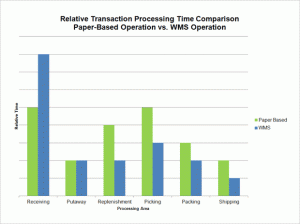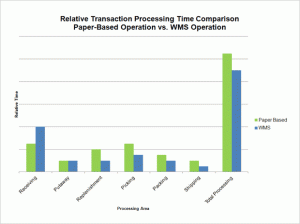Guest Commentary – Receiving: Gateway to Operations Excellence and Productivity
by Jeff Ross
Like the padlock and key that protect a building’s contents, the receiving operation safeguards the overall efficiency of your warehouse.
The typical approach when receiving product is to get it unloaded and put away as quickly as possible. At the end of the day, many warehouse managers equate a clean receiving dock with a successful operation.
Unfortunately, this approach can often create downstream problems and mask internal inefficiencies. Speed should not be the focus of receiving; in fact, speed as the primary objective can negatively impact an efficient warehouse operation.
The primary objective for the receiving operation should be accuracy. Verifying every item that enters the facility will prevent multiple downstream errors and exception conditions. Most importantly, careful validation will avert an error that causes an order line to be unfulfilled. It is axiomatic in warehouse operations: the greater the value of your inventory, the more essential the need for a closely controlled and meticulous receiving process.
Product that is not received correctly results in multiple and repeated downstream errors. Below are examples of error conditions and consequences from an incorrect receipt:
- Inventory Inaccuracy
• Misstated dollar value
• Count discrepancy
• If discovered, time and effort to correct
- Putaway
• Placement in wrong area, zone or location
• If discovered, delay while waiting on correction
- Replenishment
• Incorrect item in pick location
• If discovered, delay while waiting on correction
- Picking
• Picking the wrong item and sending it to the customer
• If discovered, delay while waiting on correction
• Shorting an order line
• Canceling an order line
- Packing
• Incorrect manifesting due to the wrong item characteristics in the carton
• If discovered, delay while waiting on correction
- Invoicing
• Incorrect charge to the customer
• Incorrect valuation of business financials
• If discovered, delay while waiting on correction - Returns
• Handling the customer complaint by Customer Service
• Return Authorization processing in systems
• Generating order for correct item and fulfillment in the DC
• Receive return
–Process RA
–Credit customer
–Disposition of product and repackage, if necessary - -Loss of customer confidence and goodwill
Catching the error in receiving prevents errors in the above areas and their penalties.
Accuracy in a DC operation is one of the chief benefits of implementing a WMS. However, with respect to the receiving operation, accuracy often comes with a price. A WMS will actually slow down a receiving operation to some degree based upon the levels of accuracy required. The key benefit of the increased time to receive: The improvement in efficiency of downstream processes.
The following chart shows the relative processing times of areas in a DC for a paper-based operation versus a WMS-controlled facility.
Note that the relative receiving processing takes longer (and can take significantly longer) in a WMS-controlled DC versus a paper-based facility. This is intentional (i.e., by design) because receiving is where most errors should be caught and corrected. Downstream processes are then more efficient because of the system-driven functionality of the WMS as well as the reduction in exception conditions.
The increased receiving time is often viewed as a negative when the focus is on receiving alone. The chart below illustrates the real benefits of the increase in receiving processing time. Although receiving processing increases time, the improvements in downstream processes more than offset that increase, as shown by the total time bars.
Whether you are operating under a WMS or not, the implementation of a disciplined receiving process will lead to an overall improvement in operating efficiency.
Jeff Ross is Vice President, Consulting with MHI member FORTE.






 Click to enlarge
Click to enlarge